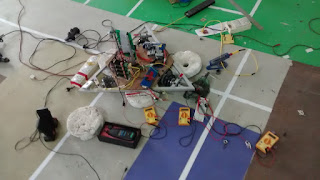From my previous
post, you can find a pdf regarding a "n wheeled driving equations". From the paper I was able to formulate equations for a three wheel drive and it followed as below,
v1 = -vx/2 + vy*sqrt(3)/2 + R*w
v2 = -vx/2 - vy*sqrt(3)/2 + R*w
v3 = vx + R*w
where,
v1 , v2, v3 are RPMs of the three wheels
vx is velocity of robot in x direction, vy is velocity of robot in y direction, w is angular velocity, R is radius of wheel
So I coded an interface for PS2 and motor control on ATMega128 controller and started testing a no control system run of the system. The code can be found
here.
Considerations of no angular velocity was taken and hence w = 0. vx and vy were equalled 100cm/s initially but the response at this RPM was sluggish and often the mechanical errors dominated a lot leading to stoppage of wheels due to gear friction itself. Later the vx and vy were updated to 200cm/s and it got rid of gear friction and mechanical imperfections. Several runs were made on robot and the PWM on each wheel was "
biased" according to the compensation required. For example, if the robot moved more to the left then the left wheel PWM was decreased. After testing several sets, today the driving concluded with the below results of no control system three wheel driving.
Obviously, the response is really bad. But it could be finer with some more tuning. This clearly declares the need of a control system.
Mechanical difficulties faced :
- The L mountings of the motor has very less ground clearance and hence touches unlevelled ground.
- Positioning wheels Allen bolts might have threads worn out.
- Gear friction is considerable.
- Some eccentricity on gear mountings.















